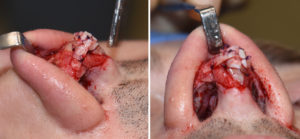Tip projection is an important part of the nasal shape that can be changed in tip rhinoplasty surgery. Tip projection is different than tip rotation as the former pulls the tip of the nose away from the face while the latter changes the axis of the tip point around the sagittal plane of the face. Changes in tip projection may not cause tip rotation but tip rotation almost always affects tip projection.
Loss of tip projection from prior rhinoplasty surgery usually blunts its shape, making it appear too round. It always make the nose look shorter and can create artificial supratip fullness or even a pseudo dorsal hump. Reconstruction of tip projection requires cartilage grafts most commonly harvested from the septum or ears. But in the cartilage depleted patient may require the use of a small rib graft for adequate grafting material.

Tip rhinoplasty can increase tip projection with the use fo cartilage grafting in a tripod construct as an onlay technique. The alternative approach is from underneath, pushing the tip out with septal extension grafting.
Dr. Barry Eppley
Indianapolis, Indiana


